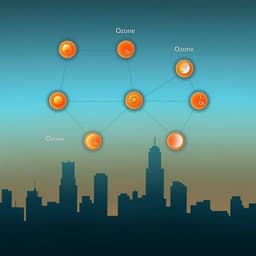
Earth Sciences
Quantifying the drivers and predictability of seasonal changes in African fire
Y. Yu, J. Mao, et al.
Explore the groundbreaking research conducted by Yan Yu and colleagues, revealing how seasonal environmental factors like sea-surface temperature and soil moisture influence African fire predictability. Their innovative use of Stepwise Generalized Equilibrium Feedback Assessment combined with machine learning techniques offers a robust method for forecasting fires a month in advance.
~3 min • Beginner • English
Introduction
Fires in Africa strongly affect ecosystems, atmospheric composition, regional climate, hydrology, human health, and infrastructure. Subtropical savannahs in Africa account for about half of fire-related carbon emissions and roughly 70% of global burned area, modulating interannual greenhouse gas concentrations. Despite the importance, seasonal prediction of African fire activity has been limited, partly because drivers such as weather, vegetation, and human activities operate on different timescales and have limited seasonal predictability. Observed climate and hydrologic variability in sub-Saharan Africa are sensitive to slowly evolving sea-surface temperature (SST) patterns and land surface states, suggesting potential sources of predictability for fire. However, the specific oceanic and terrestrial drivers and their contributions to seasonal predictability of African fire have not been systematically quantified, and the synergistic and independent roles of different SST modes remain unclear. This study aims to identify and quantify the dominant oceanic and terrestrial drivers of seasonal African fire variability and to evaluate their contribution to predictability, leveraging SGEFA to separate intercorrelated forcings and machine learning techniques to build predictive models.
Literature Review
Prior studies attribute African fire variability to climate, vegetation composition and distribution, fuel drying, and human activity. Satellite observations show a decline in burned area in northern Africa since 1998, with demographic and socioeconomic changes (e.g., population growth, cropland expansion) contributing comparably to climatic and ecological factors. Seasonal climate forecasts have produced limited skill for predicting burned area across Africa. ENSO has been the primary oceanic focus, yielding heterogeneous precipitation and fire responses, whereas roles of other basins, notably the tropical Atlantic, are less explored. Vegetation indices like LAI can both increase fuel supply and modulate surface energy and moisture, leading to complex fire responses; soil moisture generally suppresses burning but also influences fuel accumulation. Fire-enabled models represent vegetation and soil effects but often simplify their seasonal, linear and nonlinear impacts. Statistical approaches (SGEFA) have demonstrated capacity to separate contributions from intercorrelated oceanic and land forcings on seasonal timescales, while machine learning has been used to diagnose and predict fire but requires process-based guidance to avoid overfitting with short records.
Methodology
The study combines Stepwise Generalized Equilibrium Feedback Assessment (SGEFA) with multiple machine learning techniques (MLTs). SGEFA quantifies the linear, instantaneous response of a rapidly varying target (fire carbon emissions and burned area fraction) to slowly varying forcings (SST, LAI, soil moisture) at a lag τ of 1 month, after removing the seasonal cycle and linear trends. The response vector R is estimated from lagged covariances between the fire variable and the forcing matrix, under the assumption that internal noise in fire is uncorrelated with future forcing. To reduce sampling error and isolate key drivers, backward stepwise selection optimizing Akaike Information Criterion is applied to drop less important forcings. Forcings include 16 oceanic predictors: the first two principal component time series of SST empirical orthogonal functions from eight basins (tropical Pacific, tropical Atlantic, tropical Indian, North Pacific, North Atlantic, South Pacific, South Atlantic, South Indian), plus two terrestrial predictors: area-averaged regional LAI and 0–10 cm soil moisture. SSTs use Hadley Centre Sea Ice and Sea-Surface Temperature; LAI uses three satellite-based datasets; soil moisture uses two observation- and reanalysis-based datasets. Seasonal feedbacks are assessed over 3-month seasons for 1997–2016, and significance is tested via 1000-iteration Monte Carlo bootstrap at p < 0.1.
For prediction, five MLTs are evaluated: random forest, support vector machine, artificial neural network, LASSO, and gradient boosting machine. Predictors include the SGEFA-employed oceanic and terrestrial variables (with leads of 1–3 months as available) plus antecedent atmospheric factors (lightning, low-level temperature, humidity, wind speed) and socioeconomic factors (population density; land use/land cover change, typically from the antecedent year). Data are split into 15-year training and 5-year testing sets, with 10-fold cross-validation to optimize hyperparameters for minimum RMSE. Performance is evaluated by R² between observed and predicted monthly anomalies; the best-performing MLT’s R² is reported. This is repeated for 100 random splits to create an ensemble and quantify uncertainty. Both season-specific models (trained/applied by season) and all-season models (pooled seasons) are assessed; an additional robustness test shows that balanced seasonal sampling improves all-season model performance, supporting season-dependent controls.
Key Findings
• SGEFA identifies SST, soil moisture, and LAI as dominant seasonal drivers of African fire variability, with peak impacts in the respective fire-active seasons of northern (boreal winter) and southern (boreal summer) Africa.
• Oceanic drivers: ENSO exerts spatially heterogeneous influences; El Niño supports enhanced fire emissions and burned area across the northern Sahel, West African monsoon regions in boreal winter, and southwestern Africa in boreal summer via low-level warming and fuel drying. The Atlantic Niño shows a relatively homogeneous positive association with fire across much of Africa; warm tropical Atlantic SSTs induce warming over southern Africa and drying over northern Africa, enhancing fire activity.
• Terrestrial drivers: Soil moisture anomalies generally suppress fire across most of Africa via surface cooling and increased precipitation, with stronger effects during fire-active seasons. LAI exerts spatially complex effects: positive LAI anomalies can enhance fire (more fuel) in parts of West African monsoon regions and southern African grasslands, but can inhibit fire elsewhere (e.g., much of southern Africa) via surface cooling and reduced near-surface winds.
• Predictability: Including slowly evolving oceanic and terrestrial predictors substantially increases seasonal predictability relative to atmospheric and socioeconomic predictors alone. Ensemble-mean R² using all predictors decreases with lead time from 0.60 (0.52–0.77) at 1-month lead to 0.16 (0.07–0.18) at 6-month lead. In northern Africa at 1-month lead, using only oceanic and terrestrial predictors yields R² = 0.51 (0.39–0.61), versus 0.38 (0.25–0.41) using atmospheric and socioeconomic predictors. Season-specific models consistently outperform all-season models.
• Seasonality and regional differences: Northern Africa exhibits higher predictability and stronger seasonal variation than southern Africa. At 1-month lead, northern Africa’s R² ranges from 0.78 (March–May) to 0.23 (August–October), while southern Africa’s ranges from 0.51 (April–June) to 0.22 (February–April). Soil moisture attains the highest annual-average importance among predictors.
• The combined SGEFA-MLT approach provides skillful 1-month-ahead predictions of fire carbon emissions and burned area anomalies in sub-Saharan Africa, outperforming forecasts based solely on seasonal climate predictions.
Discussion
By separating and quantifying the contributions of intercorrelated, slowly evolving oceanic and terrestrial forcings, SGEFA reveals mechanistic links between SST modes (ENSO and Atlantic Niño), soil moisture, LAI, and regional fire activity. These quantified drivers, when fed into machine learning models, materially enhance seasonal predictability, addressing the challenge posed by the limited intrinsic predictability of atmospheric states alone. The findings reinforce the importance of ocean–land controls, particularly soil moisture, in shaping seasonal fire risk and explain regional and seasonal heterogeneity in fire responses. The framework’s process-oriented insights can inform development and evaluation of fire models (e.g., FireMIP), where misrepresentation of seasonally dependent drivers likely contributes to poor simulation of seasonal-to-interannual variability. Extending the framework to other fire-prone regions will require tailored predictor sets (e.g., Madden–Julian Oscillation, broader-scale vegetation anomalies in Australia) and can support regional to global early warning systems.
Conclusion
This study introduces a combined SGEFA–machine learning framework to quantify and predict seasonal African fire variability. It demonstrates that seasonal changes in fire carbon emissions and burned area across northern and southern Africa are primarily sensitive to SST, soil moisture, and LAI, which modulate burning conditions and fuel supply. Incorporating SGEFA-identified, slowly evolving predictors enables skillful prediction of fire anomalies one month in advance, surpassing approaches based mainly on seasonal climate forecasts. The framework provides process-based metrics to benchmark fire models and a foundation for regional-to-global fire early warning systems. Future research should extend observational records, increase spatial and temporal resolution, incorporate additional environmental and socioeconomic variables, refine representation of human influences, and adapt predictor sets for other regions to improve fine-scale predictability and mechanistic understanding.
Limitations
Uncertainty arises from limited observational data coverage and quality. The weak apparent role of lightning may reflect both dominant anthropogenic ignitions and data limitations. Socioeconomic predictors are constrained by sparse, low-temporal-resolution, and untested datasets, potentially underestimating human contributions. The machine learning models are trained on relatively short records with small predictor sets, contributing to uncertainty across ensemble splits. Analyses focus on broad ecoregion averages, which may obscure local-scale drivers and predictability. SGEFA’s requirement for slowly varying forcings limits assessment of rapidly varying atmospheric and anthropogenic influences, while MLT performance is sensitive to training data volume and representativeness. Finer-scale applications will require longer records, higher-resolution datasets, and expanded observable variables.
Related Publications
Explore these studies to deepen your understanding of the subject.







